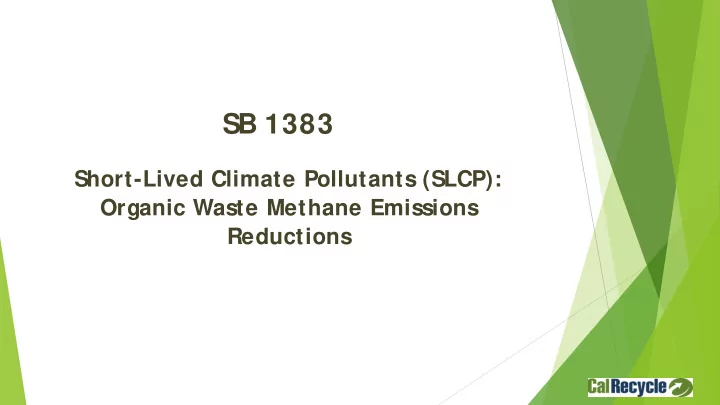

SB 1383 Short-Lived Climate Pollutants (SLCP): Organic Waste Methane Emissions Reductions
METHANE - 20x 6 MILLION stronger CALIFORNIANS greenhouse gas are FOOD than CO 2 INSECURE
What does SB 1383 Require? Waste Sector Targets HS C 39730.6(a) 50% reduct ion in the level of the statewide disposal of organic waste from the 2014 level by 2020. 75% reduct ion in the level of the statewide disposal of organic waste from the 2014 level by 2025. PRC 42652.5(a)(2) 20 percent improvement in edible food recovery by 2025. 3
What Is Organic Waste? Green materials Food materials Wood waste Fiber (Paper and Cardboard) 4
Why Organic Waste? Achieving SB 1383 Organic • Waste Reductions Reduces landfill emissions • by 4 MMTCO2e in 2030. Avoids 14 MMTCO2e • emissions over the lifetime of waste decomposition. Help reduce your CH4 emissions by reducing waste to landfills! 5
Where Are We Today? SB 1383 Organic Waste Reduction Target
2014 Waste Characterization Data Organic Waste By Sector 11% Residential Commercial 50% 39% S elf-Haul 7
How Do We Get There? Regulations SB 1383 Rulemaking Schedule 2017 informal rulemaking workshops • 2018 formal rulemaking and adoption of regulations – 2018/ 2019 • 2020 50 Percent Reduction in organics disposal (< 10M tons) • 2020 Analysis on Waste S ector Progress (CalRecycle & ARB • analysis) 2022 Regulations Take Effect • 2025 75 percent reduction in organics disposal (< 5.7M tons) • and 20 percent edible food recovered
How Do We Get There? Regulations Entities Included In SB 1383 Regulations Cities and Counties • Local Enforcement Agencies • Generators* • Haulers • S olid Waste Facilities and Recyclers • Food Recovery Organizations • End-users of Recycled Organic Products • *Generators includes single family and multifamily residential, businesses, and entities that are outside of the authority of a j urisdiction such as state entities, federal facilities, and school districts. 9
How Does This Impact Cities and Counties? How Does SB 1383 Impact Local Government? Local governments directly oversee local waste management (contracts, franchise agreements, permits, enforcement, etc.) Achieving S B 1383 targets requires new levels of collection services for generators Achieving S B 1383 targets requires new sources of organics recycling and edible food recovery capacity Achieving S B 1383 targets requires new levels of state and local oversight 10
How Does This Impact Cities and Counties? Key SB 1383 Regulatory Requirements Organics Waste Collection Program S ource-S eparated Collection Mixed Waste Collection (allowed if minimum organic waste recovery standards are met) Edible Food Recovery Programs Education Monitoring contamination and conducting targeted education Inspection and Enforcement Planning for Adequate Capacity Procurement of Recycled Content Products Reporting 11
Entities Subject to Oversight Generators of Organic Waste Minimum random and complaint based monitoring by j urisdictions Potential referral to CalRecycle for large generators that span multiple j urisdictions Potential for CalRecycle to initiate direct oversight and action when there is a failure to properly monitor or act by the j urisdiction ( S imilar t o exist ing pract ices wit h LEAs and S WFs) Haulers of Organic Waste Jurisdiction monitoring for compliance with regulatory standards Potential for CalRecycle direct oversight and action when there is a failure to properly monitor or act by the j urisdiction. ( S imilar t o exist ing process wit h LEAs and S WFs ) 12
Jurisdictions’ Oversight Oversight of generators and haulers, and edible food recovery organization Regular monitoring for compliance for entities within the j urisdictions’ oversight authority Initiate compliance actions outlined in regulations As violations are discovered, or CalRecycle notices the j urisdiction of violation 13
Potential Compliance & Enforcement Procedures by CalRecycle There is no good faith effort. However, once an entity has been deemed to be out of compliance with a regulatory requirement CalRecycle can set a timeline for coming back into compliance that avoids penalties. In setting the timeline CalRecycle will consider substantial efforts made by the entity (i.e. j urisdiction, hauler, generator) and factors outside the entities control. This allows consideration of effort and avoidance of penalties due to that effort but it is not the same as the AB 939 good faith effort compliance model. If CalRecycle finds that a jurisdiction is not fulfilling one or more of its responsibilities, then it make take one or more of the following actions: 14
Potential Compliance & Enforcement Procedures by CalRecycle Conduct more frequent inspections within the jurisdiction or 1. more frequent audits of the jurisdiction. Take direct enforcement 2. Progressive Compliance: Notice to Comply (compliance schedule i.e. 30 days to comply) Submit second Notice of Noncompliance (if violation still exists) Submit Accusation to Office of Administrative Law for penalties Establish a schedule and probationary period for improved 3. performance by the jurisdiction: 15
SB 1383 Regulatory Process Webpage: http:/ / www.calrecycle.ca.gov/ climate/ slcp/ • Listserv: http:/ / www.calrecycle.ca.gov/ Listservs/ S ubscribe.aspx? ListID=152 • Inbox: SLCP .Organics@calrecycle.ca.gov •
Recommend
More recommend